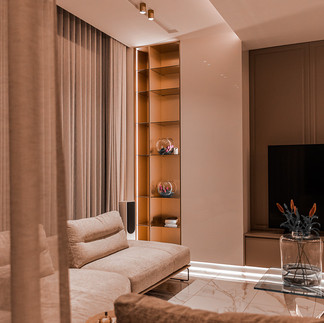Monochromatic Spaces: Depth Through Simplicity
- Theo Arewa-Bothma

- Jul 18
- 8 min read
How Texture, Tone, and Material Layering Elevate Luxury Monochromatic Interiors
Step into a world where restraint is the ultimate luxury, a space where a singular colour does not limit expression but instead invites a deeper exploration of form, material, and light. Imagine walking through a grand hallway where every surface, from the velvet softness of a chaise lounge to the cool polish of marble, whispers the same colour story, yet each element tells a different chapter. This is the quiet power of monochromatic design.
In an era obsessed with bold contrasts and maximalism, choosing to design within a single colour family is an act of refined discipline. It’s an invitation to slow down, to appreciate nuance, and to discover richness not through excess, but through subtlety. Here, texture becomes a language, tone a brush stroke, and material layering a symphony of sensory experiences. Far from boring, monochrome is a canvas for sophistication; one that, when mastered, transforms spaces into timeless statements of elegance and intentionality.
For those who value the art of understatement and the luxury of simplicity, this exploration into monochromatic interiors reveals how depth and interest are not sacrificed but amplified when you embrace the beauty of one harmonious palette.
The Power of Texture
If colour is the melody, then texture is the rhythm that breathes life into a monochromatic space. Imagine entering a room cloaked in alabaster, where your hand instinctively reaches out to feel the contrasting surfaces, a plush boucle armchair next to a sleek, polished stone hearth. Each texture invites touch, commanding attention through tactility rather than hue.
Texture in monochrome is not merely decorative; it is a master-stroke of sensory design. The interplay between rough and smooth, soft and hard, matte and lustrous creates a dynamic tension that keeps the eye wandering and the spirit engaged. It’s the whisper of silk curtains against the solidity of exposed concrete walls. The subtle grain of unfinished wood flooring grounding a room filled with satin-finished cabinetry.
In practice, the luxury lies in layering textures that echo your lifestyle and preferences. For instance, a penthouse designed for a serene retreat might marry the coolness of honed marble with the warmth of cashmere throws and sculpted wool rugs, each element adding depth without disrupting the monochrome harmony. Conversely, a dramatic urban loft might contrast raw concrete with high-gloss resin surfaces, creating an architectural dialogue within one restrained palette.
As a professional interior designer, I’ve witnessed how clients initially sceptical of a “single-color” approach are ultimately captivated by the rich sensory narrative texture imparts. It’s an invitation to experience space not just visually, but physically and emotionally, a tactile journey where every material tells a story of intention and craftsmanship.
Before choosing your palette, consider: What textures resonate with your daily rhythms? Which surfaces do you want to feel beneath your fingertips? The answer shapes not only the look but the soul of your monochromatic sanctuary.
Subtle Tone Variation
Within the elegant restraint of a monochromatic palette, subtle shifts in tone are the brush strokes that paint depth and dimension. Think of it as the soft gradient of dawn sky, where whispers of pale cream gently melt into warm beige, or the way a single note in a symphony swells and recedes to stir emotion.
In interior design, tone variation is the art of layering shades, lighter and darker versions of the same hue, to create visual movement without breaking the harmony. It’s the delicate dance between a whisper-soft wall and a slightly richer trim that frames it, or the way a plush sofa’s fabric edges into deeper shadows beneath natural light.
Consider the effect of an ombré wall, where a pale tone at the ceiling gradually deepens as it reaches the floor, inviting the eye to travel and discover hidden nuances. Or the subtle contrast of cabinetry painted just a few shades darker than the surrounding walls, lending quiet definition and sophistication.
For Studio 8687 clients, tone variation is less about stark differences and more about refinement, a whispered conversation between shades rather than a bold declaration. It’s what allows a room to feel spacious yet intimate, calm yet alive. When executed masterfully, this delicate tonal layering can elevate a minimalist scheme to an artful, almost poetic experience.
Reflect on your personal vision: Do you prefer the soft embrace of barely-there transitions, or do you desire a more dramatic tonal statement that anchors your space with authority? Your answer guides how we sculpt the atmosphere, whether it’s the serene hush of a coastal retreat or the confident poise of a metropolitan sanctuary.
In our work, we often draw inspiration from timeless interiors like Tadao Ando’s concrete masterpieces, where nuanced grey gradients interact with light and shadow to reveal endlessly changing moods.
Subtle tone variation is not just a technique; it’s a language of luxury that speaks directly to the discerning eye, an invitation to slow down, observe, and savor the quiet complexity of simplicity.
Material Layering & Finish Play
In a monochromatic interior, the dance between matte, satin, and gloss finishes is akin to the interplay of light on a still lake at dawn, each surface reflecting and absorbing light in its unique way, creating a living tapestry of subtle shifts and highlights. This nuanced layering of materials and finishes is where sophistication reveals itself through contrast without colour.
Imagine running your hand along a hand‑crafted lacquered console that gleams softly under a sculptural pendant, its mirror-like surface reflecting the matte softness of an adjacent wool rug. Nearby, brushed brass fixtures catch stray beams of sunlight, their warm metallic glow breaking the quietude of a neutral palette with understated glamour. The tactile dialogue between these finishes is an exercise in balance; too much gloss and the space risks feeling cold or clinical; too much matte and it might lack vitality.
For the discerning home-owner, material layering is about carefully curating surfaces that engage the senses while respecting the monochromatic harmony. Think of the tactile warmth of a hand‑woven silk curtain paired with the smooth solidity of honed limestone floors. Or the juxtaposition of a velvet chaise’s plush depth against the sleek precision of polished concrete counter tops. Each pairing tells a story, of craftsmanship, intent, and luxury.
At Studio 8687, we approach finish play as a form of sensory storytelling. We seek materials that not only complement each other visually but also resonate with the lifestyle they serve. For instance, in a serene retreat, the softness of matte linens and unpolished woods invite quiet relaxation, while in a more formal setting, high-gloss lacquers and metallic accents elevate the space with refined drama.
Before selecting finishes, consider: How do you want your space to feel beneath your touch? Do you desire surfaces that invite lingering contact or ones that gleam with poised perfection? The answers to these questions guide the symphony of finishes that breathe life into your monochrome sanctuary.
Material layering and finish play are subtle yet powerful tools, transforming simplicity into sensory richness and turning a single colour family into an extraordinary experience of depth and elegance.
Strategic Use of Light & Shadow
Light is the unseen architect of every interior, sculpting forms and breathing dimension into space. Within a monochromatic palette, where colour steps back, light and shadow take centre stage; casting shapes, textures, and tones into a dynamic choreography that constantly evolves throughout the day.
Imagine a serene room flooded with soft natural light filtering through sheer curtains, where every fold and surface catches the sun’s gentle caress, creating a mosaic of shifting highlights and shadows. Or picture a grand evening gathering, where hidden cove lighting washes the walls in a warm glow, and sculptural pendants cast delicate patterns that invite quiet contemplation.
The interplay of light and shadow in a monochrome setting is akin to a masterful dance. Layered lighting; ambient, task, and accent, works in concert to highlight texture, deepen tonal contrasts, and direct the eye toward architectural features or cherished objects. Recessed down lights can spotlight a textured wall, while uplighting adds depth and drama to an otherwise minimalist space.
For clients who cherish thoughtful design, we encourage considering how light will interact with every surface and material choice. Does the honed stone gain warmth under soft incandescent bulbs? Do the silk drapes shimmer subtly when kissed by morning rays? How might shadows carve a sense of intimacy in a large open-plan room?
At Studio 8687, we often draw inspiration from estates where light is meticulously orchestrated, not just to illuminate, but to reveal and transform.
In a monochromatic space, light and shadow are your greatest allies, inviting you to see the familiar anew, adding mystery, warmth, and a sense of movement that keeps simplicity endlessly compelling.
Focal Points & Breaks in Monochrome
While a monochromatic palette thrives on harmony and subtlety, the art of creating a captivating interior lies in the deliberate placement of focal points, elements that punctuate the calm and draw the eye with quiet confidence. These moments of visual interest serve as anchors, offering balance and narrative within the seamless flow of a single colour family.
Imagine a sculptural ebony console table rising like a dark silhouette against dove-grey walls, its strong form commanding attention without disrupting the room’s understated elegance. Or consider a curated art installation composed entirely of varying shades of white, a tactile relief sculpture that invites touch and reflection, becoming both statement and story.
Focal points in monochrome design are not about introducing contrasting colours but about intensifying texture, form, and scale. A hand-blown glass vase with soft curves, a monolithic stone fireplace carved with precision, or a single oversized floor cushion upholstered in plush velvet, all can serve as compelling anchors that elevate the spatial narrative.
Incorporating natural elements, like an olive tree in a tonal ceramic planter or dried pampas grass arranged in a sculptural urn, offers a breath of organic life, softening the architecture while remaining within the tonal confines. These touches introduce quiet vitality, reminding us that monochrome is not a void of expression but a canvas of possibility.
Clients often ask whether such restraint risks monotony. The answer lies in intentionality. When every object is thoughtfully chosen and every form considered, the space invites discovery, a slow unfolding of detail that rewards those with a discerning eye.
At Studio 8687, we have seen how carefully curated focal points transform a monochromatic interior from simply serene to profoundly memorable. Whether it’s a bespoke piece of furniture, a treasured artwork, or a living plant, these elements become storytellers, whispering luxury through restraint and inviting guests to linger.
Monochromatic design is a master-class in subtlety, where the absence of contrasting colours becomes a canvas for depth, texture, and light to perform their quiet symphony. It invites us to appreciate the poetry of simplicity, where every surface, every shadow, every carefully chosen material speaks volumes without uttering a word.
Through the power of texture, the grace of tonal variation, the dialogue of finishes, the dance of light and shadow, and the deliberate placement of focal points, a single colour family transforms into an immersive experience of luxury and refinement. It is a design philosophy that rewards patience and invites mindfulness, offering spaces that feel both timeless and intimately personal.
For those who cherish the elegance of restraint, monochrome is not a limitation but a celebration of intentionality, a refined journey toward interiors that resonate deeply and authentically.
At Studio 8687, we believe your home should be a sanctuary where simplicity breathes richness and every detail is a testament to thoughtful design. We invite you to explore the transformative potential of monochromatic spaces with us, where depth is found through simplicity, and luxury is defined by the harmony of one.













Comments